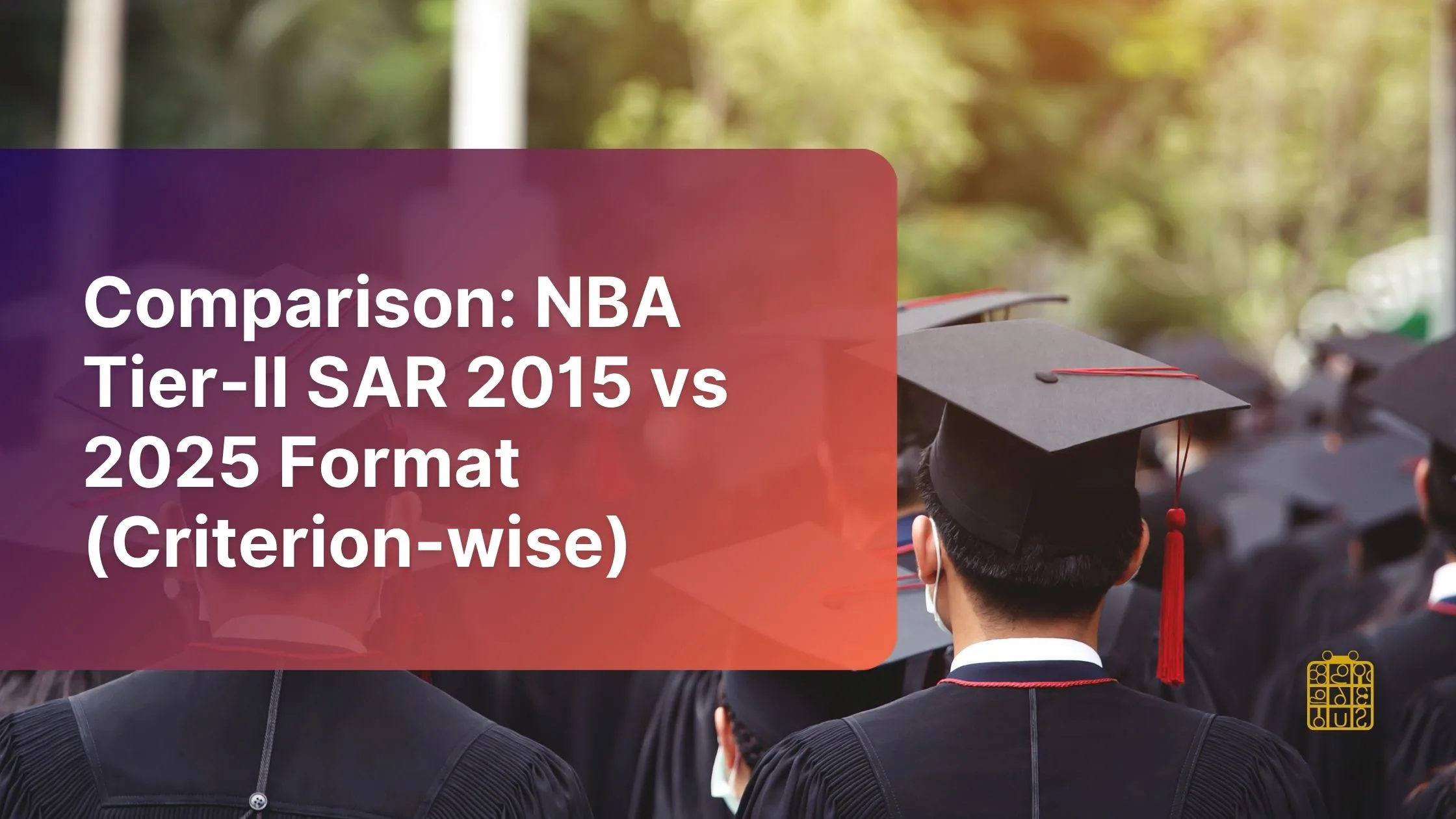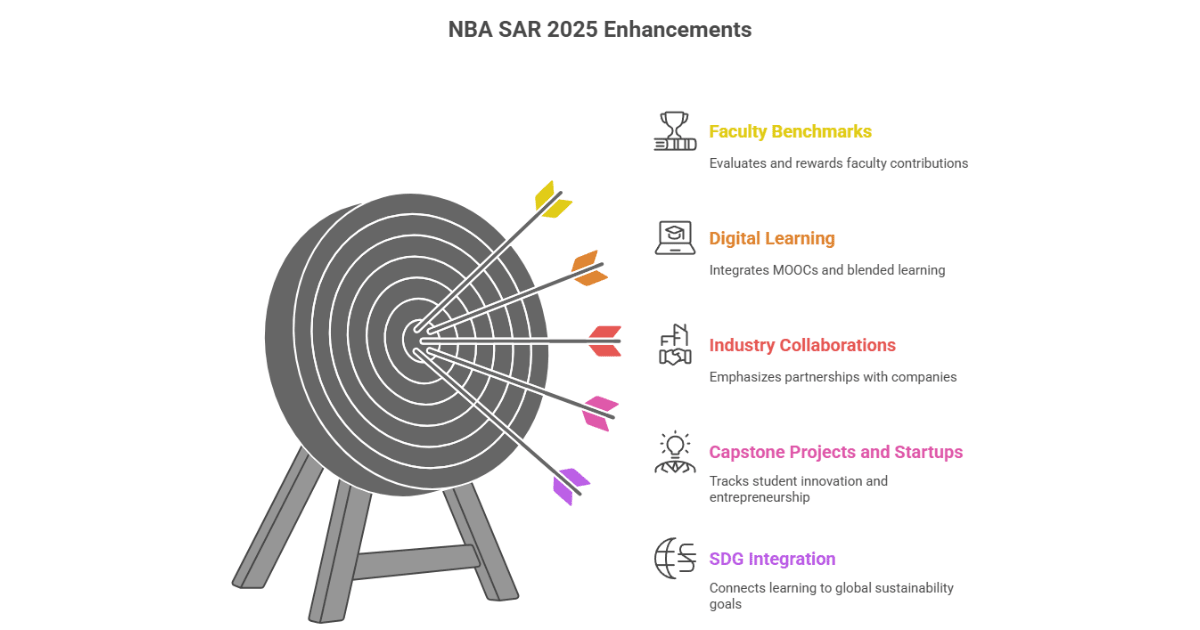NBA Tier-II SAR 2025 vs 2015: A Criterion-Wise Comparison
The NBA SAR 2025 vs 2015 comparison reveals a significant shift in accreditation strategy, focusing more on outcomes, student engagement, and continuous improvement. This blog presents a criterion-wise analysis to help institutions align with the latest format.
By, Kramah Author

In India, the National Board of Accreditation (NBA) sets the gold standard for engineering and technical programs. Accreditation is more than a certificate. It signals quality, builds trust, and ensures recognition both in India and abroad.
The 2015 Tier-II SAR followed a compliance-driven model. Colleges documented their vision statements, outlined processes, and showed they met prescribed rules. The focus was on paperwork and proof of adherence.
The 2025 SAR takes a different route. It pushes institutions toward outcome-driven education. Now, quality is measured by results; what students learn, how they apply knowledge, and where they go after graduation. Skills gained, jobs secured, startups launched, and research outputs all matter more than files and forms.
This blog explores the criterion-wise differences between NBA SAR 2015 and NBA SAR 2025. It will help institutions see how expectations have shifted and what steps they need to take to align with the new framework.
Evolution of NBA Tier-II SAR
The 2015 SAR format focused on processes. Colleges had to define their mission, outline Program Educational Objectives (PEOs), and maintain detailed records of curriculum delivery, student outcomes, and faculty data. Marks were spread across broad categories, and compliance often mattered as much as actual performance. For many colleges, accreditation felt like a documentation exercise rather than a tool for improvement.
The 2025 SAR format changes the game. It builds on India’s National Education Policy (NEP) 2020, integrates the United Nations Sustainable Development Goals (SDGs), and embraces Outcome-Based Education (OBE). The message is clear: Indian institutions should meet global benchmarks, not just local standards.
Why the shift? Several forces drove this evolution:
- Employability: Industries wanted graduates with practical skills, not just theoretical knowledge.
- Global recognition: As a Washington Accord member, India needed programs that matched international quality levels.
- Digital transformation: MOOCs, project-based learning, and online governance reshaped how education is delivered and evaluated.
Together, these drivers led to a sharper, more relevant SAR. The 2025 version rewards colleges that deliver measurable student outcomes, empower faculty, and ensure transparent governance. It marks a move away from compliance toward continuous growth and real-world impact.
Criterion-Wise Comparison: NBA SAR 2025 vs 2015
The transition from NBA SAR 2025 to SAR 2015 reflects a deeper shift in philosophy. Instead of rewarding compliance and documentation, the new framework emphasizes outcomes, transparency, and global alignment. Here’s how the criteria compare:
Curriculum (Criterion 1)
2015: Colleges were judged on Vision, Mission, and Program Educational Objectives (PEOs). Marks (50) rewarded documentation rather than innovation.
2025: The curriculum is outcome-driven and tied to NEP 2020 and the Sustainable Development Goals (SDGs). Continuous reform and innovation are expected. Marks have more than doubled to 120, signaling its central role in accreditation.
Teaching-Learning (Criterion 2)
2015: Focused on teaching processes and calculating outcomes in a traditional manner.
2025: Prioritizes active learning methods such as project-based learning, student engagement, and MOOCs. Marks remain similar, but the focus shifts to global relevance.
Outcome-Based Assessment (Criterion 3)
2015: Emphasized attainment calculations and basic quality assurance.
2025: Moves beyond calculations to stress the quality and diversity of assessment tools. Greater weight is placed on measurable and meaningful outcomes.
Student Performance (Criterion 4)
2015: Looked at aggregate scores, backlogs, and retention rates.
2025: Broadens the scope to include completion rates, professional engagement, entrepreneurship, and placement outcomes, giving a more holistic picture of student success.
Faculty (Criteria 5 & 6 in 2025)
2015: Faculty information and contributions were merged into one criterion. Evaluation included qualifications, roles, and some research activity.
2025: Splits into two criteria:
- Faculty Information: Strength, qualifications, AICTE compliance, and APAAR-linked data.
- Faculty Contributions: Research, Faculty Development Programs (FDPs), publications, and societal engagement. Both carry higher marks than before.
Facilities & Support (Criterion 7)
2015: Treated infrastructure and support services in a broad, collective way.
2025: Gives more weight to laboratories, digital resources, and modern learning infrastructure, though the total marks remain unchanged at 100.
Continuous Improvement (Criterion 8)
2015: Colleges showed evidence of periodic review and updates.
2025: Makes the process data-driven, with structured audits, documented feedback loops, and measurable improvement cycles. Marks remain at 80, but expectations are higher.
Student Support & Governance (Criterion 9 – New Format)
2015: Governance and support were scattered across different categories.
2025: Introduces a dedicated criterion with 120 marks, covering digital governance, transparency, and student empowerment. The focus is on policy-driven support systems and accountability.
Notable Additions in NBA SAR 2025

Beyond criterion-wise shifts, the 2025 SAR introduces several new dimensions that reflect modern educational priorities:
- SDG Integration: Programs must connect learning objectives to global sustainability goals.
- Capstone Projects and Startups: Colleges must track and report student-driven innovation and entrepreneurship.
- Industry Collaborations: Stronger emphasis on partnerships with companies and research bodies.
- Digital Learning: MOOCs and blended learning are no longer optional but integral to teaching strategies.
- Faculty Benchmarks: Development programs, research output, and societal contributions are tracked and rewarded.
These additions ensure that the accreditation process moves beyond compliance to foster innovation, accountability, and real-world impact.
Mark Distribution Shifts
Comparative Table: SAR 2015 vs SAR 2025
| Criterion | 2015 Marks | 2025 Marks | Shift |
|---|---|---|---|
| Curriculum | 60 | 100 | ↑ Major focus on NEP 2020 & SDGs |
| Teaching-Learning | 100 | 120 | ↑ Strong push for active learning & MOOCs |
| Outcome-Based Assessment | 120 | 150 | ↑ More weight on measurable outcomes |
| Student Performance | 150 | 180 | ↑ Includes placements, startups, engagement |
| Faculty (Qual. + Contributions) | 200 (combined) | 120 + 100 | ↑ Split for clarity and depth |
| Facilities & Support | 80 | 100 | ↑ Labs, digital infra prioritized |
| Continuous Improvement | 50 | 80 | ↑ Data-driven, audit-based |
| Student Support & Governance | — | 70 | ↑ New, structured criterion |
Key Insights
- Student performance and outcomes now dominate scoring.
- Faculty contributions, research, and outreach are measured separately.
- Digital readiness and governance transparency are no longer optional.
Practical Implementation Advice for Institutions
Adopt digital documentation and analytics
Use ERP, OBE, and accreditation software. Ensure real-time data capture for reports and audits.
Strengthen faculty development
Encourage FDPs, AICTE compliance, and APAAR integration. Build culture of continuous learning.
Enhance student outcomes
Focus on placements, internships, entrepreneurship, and SDG-linked activities. Track outcomes systematically.
Build transparent governance
Digitize records, feedback, and decision-making processes. Empower student bodies with structured roles.
Conclusion
SAR 2025 isn’t just an upgrade. It’s a Ideal shift. The move from compliance checklists to outcome-driven benchmarks aligns Indian engineering education with global standards.
Institutions that embrace these changes will gain credibility, employability edge, and global recognition. Those who resist will lag.
References For Further Reading
- Blog series by Deepesh Divakaran (NBA & OBE expert)
- NBA official documents & SAR 2025 format
- NEP 2020 framework
- Insights from NBA-accreditation experts on LinkedIn
Summary:
NBA SAR 2025 shifts focus from compliance to outcomes. Higher weight for student performance, faculty contributions, digital readiness, and SDG alignment. Institutions must adopt digital systems, strengthen faculty, and track student outcomes to stay globally competitive.
Is your institution ready to transition to the NBA SAR 2025 format?
 Need Help with NBA Accreditation?
Need Help with NBA Accreditation?
Kramah Software offers AI-powered accreditation solutions tailored for NBA SAR 2025.

Frequently Asked Questions
(FAQs)
What is the main difference between NBA SAR 2025 and 2015 formats?
SAR 2025 shifts from documentation to outcome‑based evaluation, with new sub‑criteria like SDGs, capstones, and industry engagement.
Why has the NBA introduced a new SAR format in 2025?
The 2025 format aligns with global accreditation standards and India’s NEP 2020 goals. It ensures institutions focus on practical skills, industry relevance, and measurable outcomes.
Why does NBA accreditation matter for colleges in India?
It builds credibility, improves placements, attracts funding, and ensures international recognition through the Washington Accord.
Has the weightage of criteria changed in NBA SAR 2025?
Yes, certain criteria now carry higher weightage. For example, Criterion 1 (Curriculum) increased from 50 to 120 marks, reflecting the importance of educational strategy and OBE integration.
Are faculty qualifications and contributions treated differently in 2025?
Yes. Unlike 2015, the 2025 format separates faculty qualifications and contributions into two criteria, allowing better evaluation of individual and institutional academic strength.
How can institutions prepare for the NBA SAR 2025 format?
Institutions should adopt accreditation management software, encourage faculty development, focus on student engagement activities, and ensure data-driven decision-making for continuous improvement.
Can Tier II colleges still use the 2015 format?
Only until June 30, 2025. After that only SAR 2025 format is accepted
